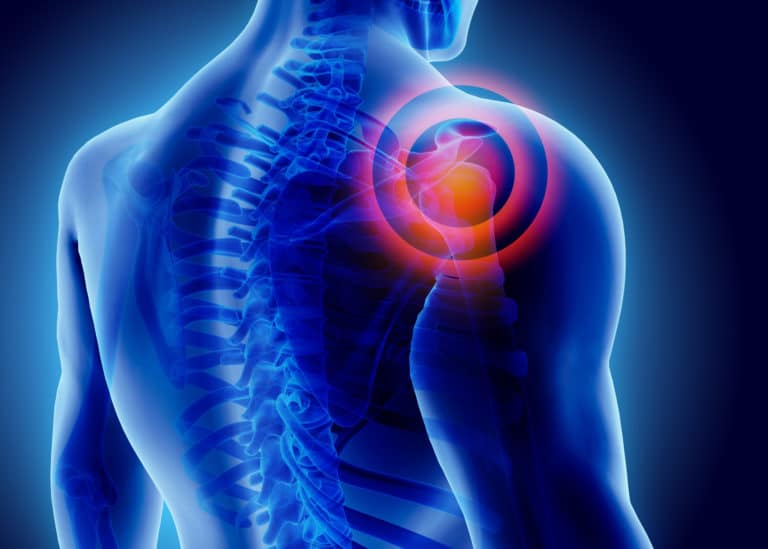At any given time, one in four adults is dealing with shoulder pain. This makes it one of the most common regional pain syndromes, along with back pain and headaches.
Do your shoulder muscles feel tight, tense, and stiff? Have you noticed your range of motion isn’t what it used to be? Do you often suffer from pain between your shoulder blades or pain in the shoulder joint itself?
Shoulder pain can be debilitating, but the good news is there are plenty of ways to manage it. Before we discuss natural treatment options, let’s first examine six common causes of shoulder pain.
Keep reading to learn more!
1. Tendonitis
Any medical term with an “-itis” in the name refers to some type of inflammation. Tendonitis occurs when there’s inflammation in one of the tendons that attach muscles to the shoulder joint.
Symptoms of tendonitis include:
- Pain that gets worse with movement
- A crackling or grating feeling around the affected joint
- Heat, swelling, or tenderness
- A visible lump along the tendon
Shoulder tendonitis most often occurs in one or more of the four rotator cuff tendons that cover the head of the humerus (upper arm bone). Tendonitis can also occur in the biceps tendon that attaches to the front of the shoulder joint.
Some cases of tendonitis are acute. The area can become painfully inflamed after repetitive physical exertion, such as throwing a ball or painting a high wall. Other cases of tendonitis are chronic, developing after years of overuse and wear and tear.
2. Bursitis
Each of your joints (including your shoulder) is cushioned by small, fluid-filled sacs known as bursae. As the “-itis” implies, bursitis is an inflammation of these delicate fluid sacs.
Most cases of bursitis result from overuse and repetitive movements of the joint. It’s a common occurrence in carpenters, painters, and professional athletes, especially baseball and softball players. However, bursitis is also linked to other conditions such as gout, rheumatoid arthritis, and thyroid disease.
Common symptoms of bursitis include:
- A dull, constant ache with mild tenderness
- Pain on the outside and top of your shoulder
- Sharp, pinching pain with movement (especially reaching overhead)
- Limited and painful range of motion
- Worsening pain when lying on the affected side
Bursitis and tendonitis often occur at the same time, creating a cycle of pain, stiffness, and inflammation.
3. Arthritis
As we age, our joints exhibit signs of wear and tear. Some cases of shoulder pain are a result of arthritis — usually osteoarthritis or degenerative joint disease. Rheumatoid arthritis (a type of autoimmune disorder) can also affect the shoulder joint.
During middle age and into our senior years, the cartilage between our bones gradually breaks down. You might think of knees or hands when you think of arthritis, but it commonly affects the shoulder joints too.
Signs of arthritis include pain, stiffness, and swelling that develop slowly and get worse over a long period of time.
4. Sports Injuries
Professional athletes aren’t the only ones who can get taken down by an injury. It’s just as common for youths playing on a school team or adults trying to maintain a healthy exercise routine.
Some common sports injuries that affect the shoulder include:
- Shoulder dislocation
- Tendon tears
- Muscular strains and sprains
- Bone fractures
- Rotator cuff injury
Keep in mind that a related injury can cause referred pain in different parts of your body. For example, a neck injury could result in nerve compression that leads to pain in your shoulder or arm. Or you may have a mild case of tendonitis that, over time, develops into frozen shoulder syndrome.
If you suspect your shoulder pain is due to an injury, visit a doctor in your area to get a proper diagnosis.
5. Impingement Syndrome
Impingement syndrome is another leading cause of shoulder pain. It’s so common in swimmers that it’s also called “swimmer’s shoulder,” but it can affect anyone who overuses their shoulder muscles.
This syndrome happens when the acromion (the top of your shoulder blade) puts pressure on the underlying tissues as you lift your arm. In other words, it “impinges” those tendons, bursae, and other soft tissues.
Over time, this can lead to some of the conditions we mentioned earlier, such as bursitis and rotator cuff tendonitis. Someone suffering from impingement syndrome may have a severely limited range of motion along with weakness and pain in the affected arm.
6. Frozen Shoulder Syndrome
If you’ve been struggling with shoulder pain for months or even years, it’s possible that you’ve developed frozen shoulder syndrome.
This occurs when the shoulder capsule (the tissue that holds the joint together) becomes tight, stiff, and thick. As a result, it becomes more difficult and more painful to try to move your arm and shoulder. No one knows exactly what causes this syndrome, but it’s likely a buildup of scar tissue after an injury or fracture.
Frozen shoulder syndrome typically affects your dominant shoulder, but it may occur in either one (or even both shoulders at the same time). It’s not uncommon for the pain to worsen over a period of 2-3 years.
Get Natural Relief for Your Shoulder Pain
Shoulder pain can be debilitating, affecting your ability to work, sleep, and do the activities you love. As we discussed above, there are a variety of conditions and ailments that can lead to shoulder pain.
The good news is that you don’t have to suffer from chronic shoulder pain forever. There are many safe and effective treatment options that don’t involve pills, injections, or surgery. In fact, chiropractic care is one of the best ways to treat shoulder pain and related symptoms.
The experts at Momentum Medical feel your pain. Our compassionate team is here to give you the relief you need from shoulder pain, back pain, and injuries due to sports or accidents.
Give us a call at (855) 944-1747 or find a convenient office location near you. We’re happy to answer your questions about chiropractic care and get you on the road to recovery.

